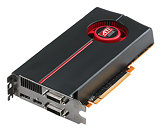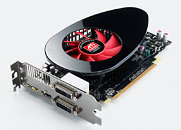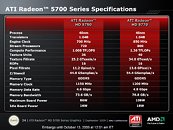- Joined
- Oct 9, 2007
- Messages
- 47,205 (7.56/day)
- Location
- Hyderabad, India
| System Name | RBMK-1000 |
|---|---|
| Processor | AMD Ryzen 7 5700G |
| Motherboard | ASUS ROG Strix B450-E Gaming |
| Cooling | DeepCool Gammax L240 V2 |
| Memory | 2x 8GB G.Skill Sniper X |
| Video Card(s) | Palit GeForce RTX 2080 SUPER GameRock |
| Storage | Western Digital Black NVMe 512GB |
| Display(s) | BenQ 1440p 60 Hz 27-inch |
| Case | Corsair Carbide 100R |
| Audio Device(s) | ASUS SupremeFX S1220A |
| Power Supply | Cooler Master MWE Gold 650W |
| Mouse | ASUS ROG Strix Impact |
| Keyboard | Gamdias Hermes E2 |
| Software | Windows 11 Pro |
AMD today released its ATI Radeon HD 5700 series of mid-range graphics processors aimed to increase the company's competitiveness in the sub-$200 market, and present a mainstream graphics card series compliant with the DirectX 11 API. The series makes use of AMD's 40 nm Juniper graphics processor, that packs 1.04 billion transistors, 800 stream processors, 40 texture units, and 16 raster operation units. The 128-bit wide GDDR5 memory interface provides up to 76.8 GB/s of memory bandwidth.
The higher-end product of the two on offer, Radeon HD 5770 is priced around the $150 mark, and has all its 800 stream processors and 40 texture units enabled. It comes with clock speeds of 850/1200 MHz (core/memory), while the Radeon HD 5750 looks to cash in on the $120 point. It has 720 stream processors, 36 texture units enabled from its kitty, with clock speeds of 700/1150 MHz (core/shader). While the Radeon HD 5770 comes with 1 GB of memory, the Radeon HD 5750 comes in variants of 1 GB and 512 MB. Some of the other big selling points of these cards are low rater power consumptions of 16~18 W at idle, and 86~108 W at load. The connectivity options include two DVI-D, and one each of DisplayPort and HDMI. The cards support AMD's Eyefinity technology which allows combining three 2560x1600 pixel display-heads for a single large display head. Each of these can pair with up to three more of its kind for 4-way CrossFireX multi-GPU performance upscaling.
All major AMD board vendors, such as ASUS, Sapphire, HIS, PowerColor, Gigabyte, MSI, VisionTek, XFX, among others, have their offerings based on these GPUs ready to sell from today. Pictured below (in order) are Radeon HD 5770 and Radeon HD 5750.



View at TechPowerUp Main Site
The higher-end product of the two on offer, Radeon HD 5770 is priced around the $150 mark, and has all its 800 stream processors and 40 texture units enabled. It comes with clock speeds of 850/1200 MHz (core/memory), while the Radeon HD 5750 looks to cash in on the $120 point. It has 720 stream processors, 36 texture units enabled from its kitty, with clock speeds of 700/1150 MHz (core/shader). While the Radeon HD 5770 comes with 1 GB of memory, the Radeon HD 5750 comes in variants of 1 GB and 512 MB. Some of the other big selling points of these cards are low rater power consumptions of 16~18 W at idle, and 86~108 W at load. The connectivity options include two DVI-D, and one each of DisplayPort and HDMI. The cards support AMD's Eyefinity technology which allows combining three 2560x1600 pixel display-heads for a single large display head. Each of these can pair with up to three more of its kind for 4-way CrossFireX multi-GPU performance upscaling.
All major AMD board vendors, such as ASUS, Sapphire, HIS, PowerColor, Gigabyte, MSI, VisionTek, XFX, among others, have their offerings based on these GPUs ready to sell from today. Pictured below (in order) are Radeon HD 5770 and Radeon HD 5750.



View at TechPowerUp Main Site






 I personally believe noise comes with speed. Wattage isn't a huge worry to me, but I'm sure it is to others, with any of todays cards it seems amps is the thing to worry about as cards are getting very hungry for them. DX11 is the bonus, but with the power of this card, will it really have the ability to push DX11 smoothly?
I personally believe noise comes with speed. Wattage isn't a huge worry to me, but I'm sure it is to others, with any of todays cards it seems amps is the thing to worry about as cards are getting very hungry for them. DX11 is the bonus, but with the power of this card, will it really have the ability to push DX11 smoothly?